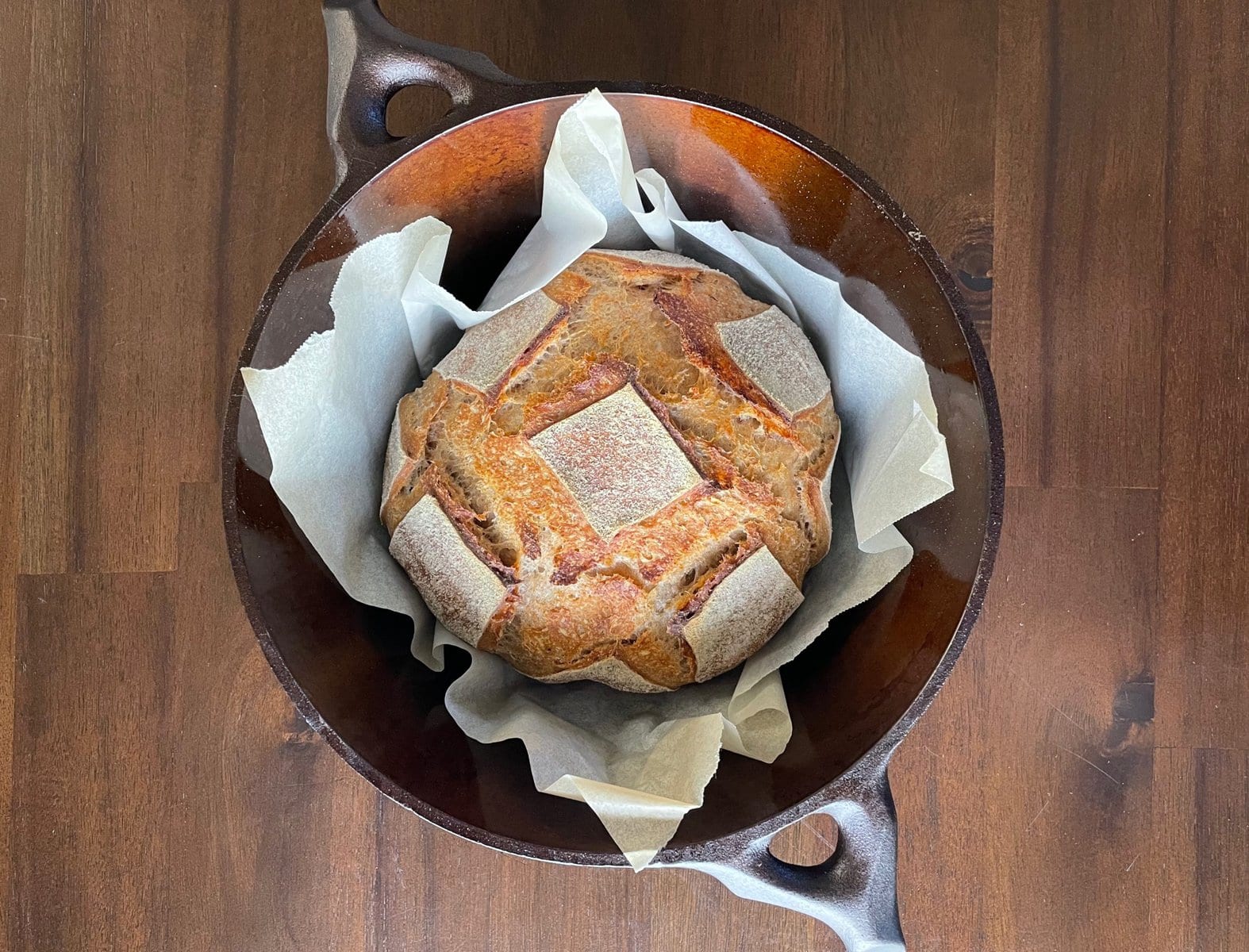
50% Whole Wheat No-Knead Sourdough Bread
This loaf requires no-kneading, just mix the ingredients and wait for the magic to happen. With 50% whole wheat flour it has a pleasant balance between the earthiness of wheat and the subtle tang of sourdough. It is a highly versatile loaf—ideal for toast, sandwiches, bread bowls, dinner bread, or, really, whatever you like. There are two options for sizes: a smaller loaf that is great for a family of 1-3, and a standard size loaf for larger families, or those that really love bread. Either makes a great gift, but the hardest part is trying to resist tearing into it before you get a chance to give it away.
Ingredients
Standard Sized Loaf
- 20 grams (1 tbsp plus 1 tsp) active sourdough starter
- 320 grams (1⅓ cup) water
- 195 grams (1¼ cup) whole wheat flour
- 189 grams (1⅓ cup) all-purpose or bread flour
- 9 grams (1½ tsp) fine salt
Smaller Sized Load
- 15 grams (1 tbsp) active sourdough starter
- 240 grams (1 cup) water
- 156 grams (1 cup) whole wheat flour
- 142 grams (1 cup) all-purpose or bread flour
- 6 grams (1 tsp) fine salt
Options
- rice flour or wheat bran for dusting proofing basket
Instructions
- In a small bowl whisk together starter and water until starter has dissolved and mixture is bubbly.
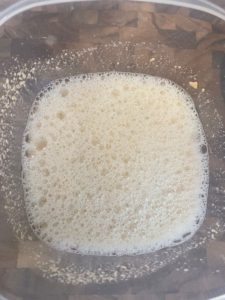
- In a large clear bowl or container whisk together flours and salt. Add dissolved starter to dry ingredients and mix quickly to form a shaggy dough. Avoid over-mixing and stop once no dry bits remain. Cover with a towel and let sit for 20–30 minutes.
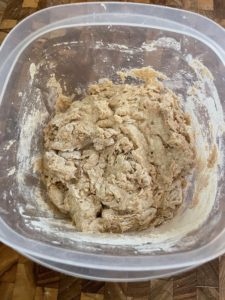
- Wet your hands and reach under the dough. Grab one side of the dough and gently stretch and fold it over the other side of the dough. Quarter turn your container and repeat until you have folded dough four times. The mixture should transform from a shaggy mass into a smoother, more cohesive dough. Mark the position of the top of the dough on the side of the container with a washable marker or rubber band. Cover with a towel.
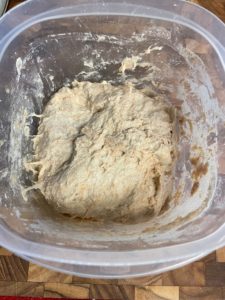
- Leave dough to rise at room temperature until it has increased in volume by about 50–100%. This can take around 6–12 hours depending on the ambient temperature and the strength of your starter. If room temperature is below 70°F (21°C) consider proofing in an empty oven with the light on (but leave yourself a note so you don’t accidentally heat the oven while it is in there).
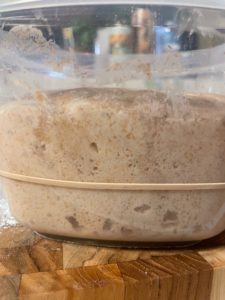
- Fill a small bowl with water and use it to wet your hands. Release dough from the sides of the container and transfer to a lightly floured work surface. Gently stretch the dough into a rough square about 5x5-inches. Wet hands as needed if dough is sticking. Fold each corner of the square into the middle. Cover with a towel and allow to rest for 15–20 minutes.
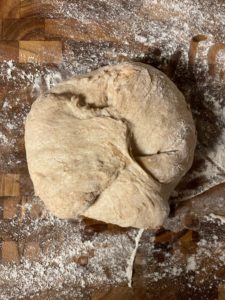
- Line a proofing basket or 8–10-inch bowl with a towel and dust with rice flour, wheat bran, or a heavy sprinkling of all-purpose or bread flour. Wet hands and again fold each corner of the dough into the middle. Repeat, folding the corners into the middle, as needed until dough is in a taut ball. Stop before dough starts tearing. Pinch the seems closed.
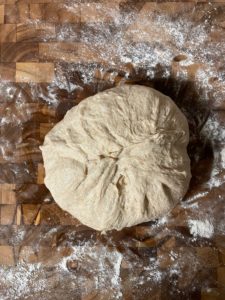
- Transfer dough to prepared basket or bowl seem-side-up. Dust the exposed side of dough with whatever you used to flour the basket. Cover with a towel. Transfer dough to the fridge and allow to proof for 12–24 hours (don’t anticipate the dough to noticeably grow when proofing in the fridge). Alternatively, you can proof at room temperature for about 2–4 hours, until dough has roughly doubled in volume. When done proofing a finger indent in the dough should spring back slowly.
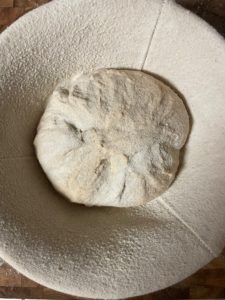
- An hour before you plan to bake place the pot and lid of a Dutch oven side-by-side on the middle rack of oven and preheat to 450°F (232°C). Once oven has preheated for about an hour prepare a square of parchment paper roughly 8x8-inches. Gently flip the dough onto parchment paper seem-side-down. Score the top of the loaf about ¼-inch deep with a serrated knife or razor blade. This can be a single slash, a cross, a square, or any pattern you like.
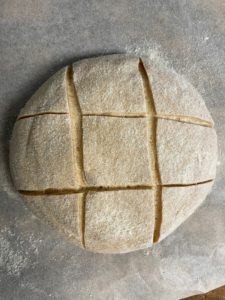
- Remove preheated pot and lid from the oven and carefully lower dough into the pot. Add an ice cube to the pot underneath parchment paper and cover with lid. Bake for 20 minutes then remove lid and bake for an additional 20-30 minutes (see recipe notes) or until loaf is deeply golden brown and sounds hollow when tapped on the bottom. Remove to a wire rack and cool completely—at least an hour—before cutting or tearing into your bread.
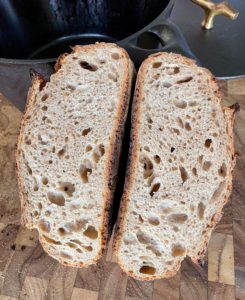
Notes
Bake loaf for less time if you prefer a less crispy crust with a lighter, cleaner flavor, bake for longer if you prefer a crispier crust that has a deep flavor with notes of coffee and chocolate. A darker crust can also be achieved by increasing baking temperature to 500°F.
Bread will stay fresh for a day or two if left at room temperature, preferably in a bread box or paper bag. For longer storage place in a plastic bag and refrigerate for up to a week. Bread can also be frozen for even longer storage.